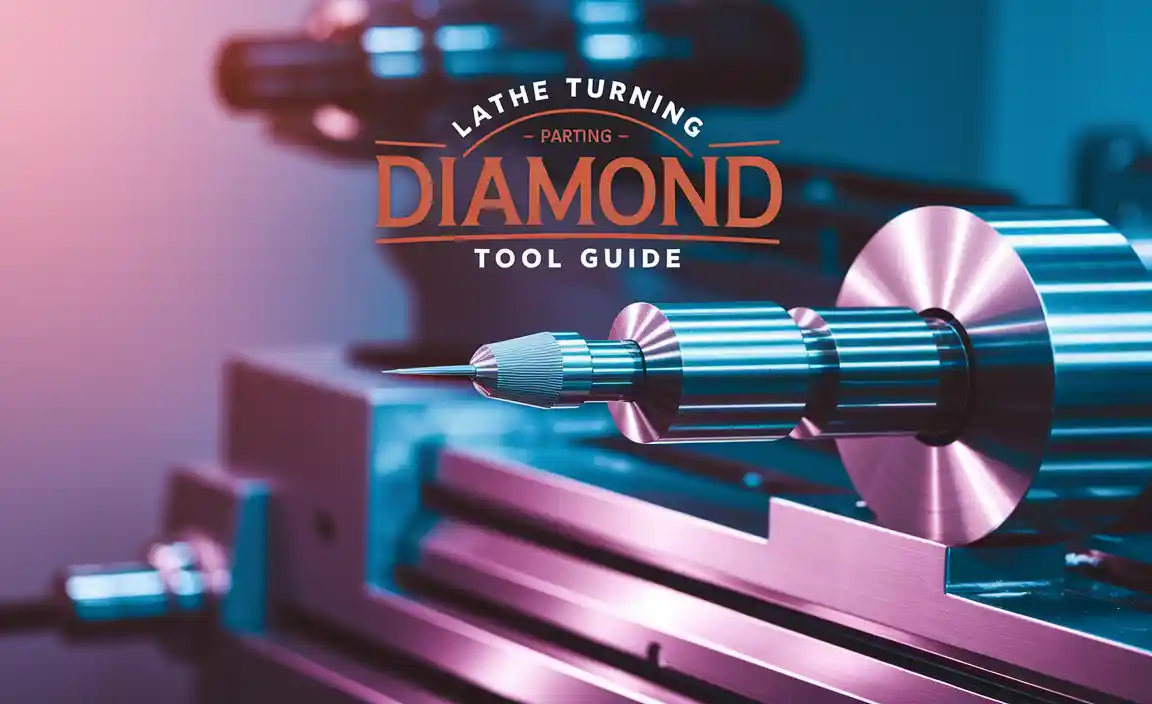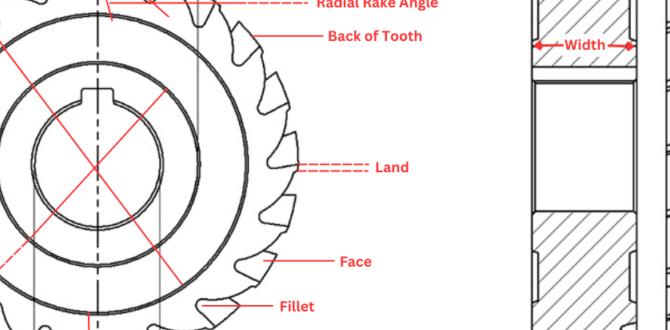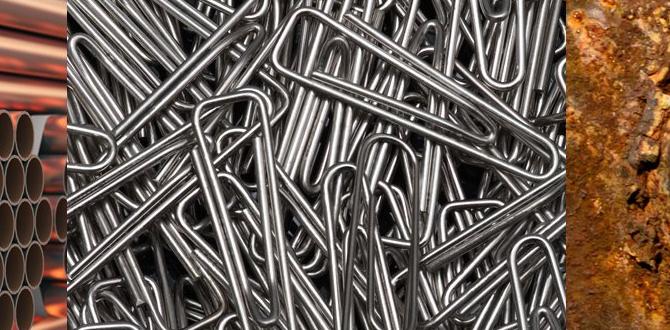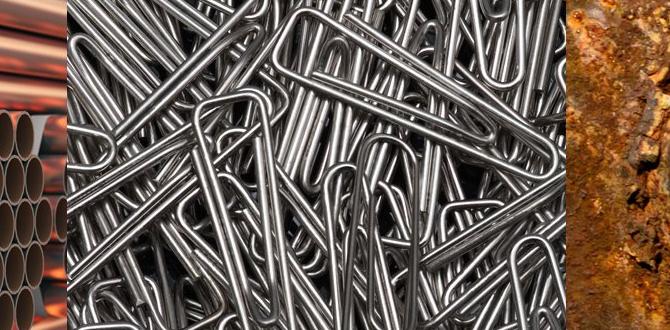Have you ever watched a metal lathe in action? It’s fascinating how this machine can shape raw metal into precise parts. Among its many components, the lathe compound rest plays a crucial role. But what exactly does it do?
Imagine crafting a small part for your favorite model car. You need accuracy and smooth movements. The compound rest on a lathe helps with that. It allows you to move the cutting tool at different angles. This makes it easier to create intricate designs.
Did you know that the design of the lathe dates back to ancient Egypt? That’s right! Those skilled craftsmen laid the groundwork for what we use today. Understanding how the lathe works can inspire you to create your own metal masterpieces.
Join us as we explore the world of lathe machining. Discover the magic behind the metal lathe compound rest. You might find yourself eager to try it out!
Lathe Machining: Understanding The Metal Lathe Compound Rest Lathe Machining Is A Fundamental Process In Metalworking, Allowing For Precise Shaping And Fabrication Of Components. Among The Key Features Of A Metal Lathe Is The Compound Rest, Which Plays A Crucial Role In Enhancing The Lathe’S Versatility And Accuracy. In This Article, We’Ll Explore What A Compound Rest Is, Its Functionalities, And Tips For Using It Effectively In Your Lathe Machining Projects. What Is A Compound Rest? The Compound Rest Is A Vital Component Of A Metal Lathe That Allows For Angular Movement And Adjustments. It Consists Of A Slide That Can Be Moved Along The Cross Slide, Enabling The Operator To Position The Cutting Tool At Various Angles Relative To The Workpiece. This Feature Is Essential When Performing Tasks Such As Taper Turning Or Threading. Benefits Of Using A Compound Rest 1. **Increased Precision**: The Ability To Adjust The Angle Of The Cutting Tool Means Greater Accuracy In Machining, Leading To Better-Finished Parts. 2. **Versatile Operations**: With A Compound Rest, Operators Can Perform A Wider Range Of Machining Operations, Including Angled Cuts And Intricate Shapes, Which Would Be Difficult To Achieve Otherwise. 3. **Enhanced Control**: The Setup Allows Users To Make Fine Adjustments, Ensuring That The Tool Is Positioned Perfectly For The Desired Cut. Key Features Of The Metal Lathe Compound Rest – **Swiveling Base**: The Compound Rest Is Equipped With A Base That Can Swivel, Allowing For Precise Angular Adjustments. – **Graduated Dial**: Most Compound Rests Feature A Graduated Dial For Accurate Reading Of The Angle, Facilitating Repeatable And Consistent Setup. – **Tool Holder**: It Often Includes A Dedicated Area For Securing The Cutting Tools, Which Helps In Changing Tools Quickly And Efficiently. How To Use The Compound Rest Effectively 1. **Set The Workpiece Securely**: Before Making Any Adjustments, Ensure The Workpiece Is Firmly Secured In The Lathe. 2. **Adjust The Compound Rest**: Loosen The Locking Mechanism, Rotate The Compound Rest To The Desired Angle, And Retighten It To Keep It In Position. 3. **Check The Tool Position**: Use A Dial Indicator To Verify That The Tool Is At The Correct Angle And Distance From The Workpiece. 4. **Make Test Cuts**: Before Commencing With The Actual Machining, Perform A Few Test Cuts To Ensure Accuracy. 5. **Repeat As Necessary**: If Your Project Involves Multiple Angles Or Features, Don’T Hesitate To Adjust The Compound Rest Throughout The Process. Conclusion The Compound Rest Of A Metal Lathe Is An Indispensable Tool For Any Metalworking Enthusiast. By Understanding Its Functionality And How To Utilize It Effectively, Machinists Can Achieve Higher Precision And Greater Flexibility In Their Projects, Leading To Better Overall Outcomes. Whether You’Re A Beginner Or A Seasoned Pro, Mastering The Use Of The Compound Rest Is Key To Successful Lathe Machining.
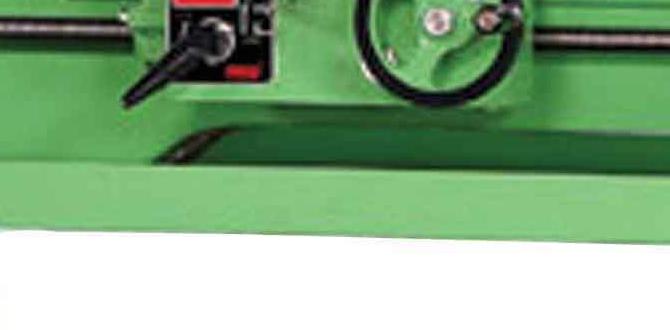
Lathe Machining: Understanding the Metal Lathe Compound Rest
Are you curious about how metal lathes work? The compound rest is a vital part of a metal lathe. It allows you to move the cutting tool in different directions. This flexibility is crucial for creating precise shapes. Did you know that the compound rest can help you make both angled and straight cuts? By mastering this component, you can improve your lathe machining skills significantly. Discover how this useful tool enhances your projects and makes machining easier!The Components of a Metal Lathe
Key parts and their functions: bed, headstock, tailstock, and carriage. Importance of each component in the machining process.Understanding how a metal lathe works is exciting! This machine has several key parts, each with its own important job. Here are the main components:
- Bed: The sturdy base. It supports all parts and keeps everything in place.
- Headstock: The front part. It holds the motor and spindle, controlling the rotation of the workpiece.
- Tailstock: Located at the back, it supports the other end of the workpiece, allowing for more stability.
- Carriage: This moves the cutting tool. It helps shape the material as it spins.
Every part is vital for smooth machining. They work together to create precise shapes from metal. Without them, turning raw metal into something useful would be much tougher.
What does each lathe component do?
Each lathe part plays a unique role, making the process efficient and accurate. For instance, the bed keeps everything steady, while the headstock includes the motor that spins the workpiece. The tailstock improves stability, and the carriage allows the cutting tool to move. This teamwork leads to better results in metalworking!
The Compound Rest: An Essential Component
Definition and function of the compound rest. How the compound rest influences precision and accuracy in machining.The compound rest is a crucial tool on a metal lathe. It holds the cutting tool and can move in different directions. This helps create precise shapes in metal. With it, the machinist can make fine adjustments, enhancing both precision and accuracy. This is important for making parts that fit together perfectly. Without a good compound rest, machining would be much harder. Having it means fewer mistakes and better finished products.
What does the compound rest do?
The compound rest allows for easy angle changes. It helps make neat and exact cuts on the metal. Another strong point is that it heightens the ability to create curves and detailed shapes. This improves product quality.
Key Functions:
- Supports tool movements
- Adjusts angles for accuracy
- Enables fine detail work
Setting Up the Compound Rest
Stepbystep process for properly setting up the compound rest. Common mistakes to avoid during setup.To set up the compound rest properly, follow these steps:
- Start by loosening the locking screws.
- Slide the rest to the desired position.
- Adjust the angle as needed.
- Tighten the screws securely.
- Double-check alignment before starting.
Avoid these common mistakes:
- Forgetting to check alignment.
- Not tightening screws enough.
- Overlooking the tool height.
Remember, a good setup leads to better results!
What are the steps to set up a lathe compound rest?
Follow these steps: loosen screws, position the rest, set the angle, and tighten screws. Always check your alignment!
What common mistakes should be avoided?
- Not double-checking alignment
- Insufficiently tightening screws
- Ignoring tool height
Techniques for Using the Compound Rest Effectively
Various machining techniques that utilize the compound rest. Tips for achieving optimal results with the compound rest.Using the compound rest can be like having your cake and eating it too! First, try angle cuts to shape your metal things efficiently. Next, feed rates are crucial—go slow for shiny results! Remember to check your tool height for the perfect match to the work piece. A well-oiled lathe is like a happy dog; it works better with a little care. Here’s a quick table to keep things organized:
| Technique | Tip |
|---|---|
| Angle Cuts | Use steady hands and a keen eye. |
| Feed Rates | Slow and steady wins the race. |
| Tool Height | Match it to your work piece! |
Follow these tips and you’ll be a lathe master in no time!
Maintenance of the Compound Rest
Importance of regular maintenance for longevity and performance. Recommended maintenance practices and schedules.Taking care of the compound rest is important. Regular maintenance can help it last longer and work better. When you clean and oil it, you prevent rust and wear. Check it often, maybe once a month. Following these steps helps:
- Clean the surface every week.
- Oil moving parts once a month.
- Inspect for damage every three months.
Keep your lathe in good shape and it will serve you well.
Why is regular maintenance important?
Regular maintenance helps prevent problems and keeps your tools running smoothly. It also saves you time and money by avoiding major repairs down the road.
Common Issues with Compound Rests and Troubleshooting
List of typical problems encountered with compound rests. Troubleshooting tips for common issues.Compound rests can be tricky little creatures. They often have issues that can make machining a real headache. Common problems include misalignment, sticking movement, and loose parts. Let’s tackle these pesky issues!
| Problem | Troubleshooting Tip |
|---|---|
| Misalignment | Check the alignment regularly. |
| Sticking movement | Lubricate the moving parts. |
| Loose parts | Tighten screws and bolts. |
Remember, fixing these problems can save you time and keep your lathe dancing smoothly. Who knew that keeping a machine happy was this easy?
Choosing the Right Lathe for Your Needs
Factors to consider when selecting a lathe with a compound rest. Recommendations for beginner to advanced users.Picking the right lathe can feel like searching for a needle in a haystack, but don’t worry, we’re here to help! First, think about the size of your projects. A small lathe is great for details, while a larger one can handle bigger jobs. Next, consider the compound rest. It helps to make precise cuts. Beginners may want a simple model, while advanced users might prefer something with more features. Remember, happy lathing means fewer headaches!
| Experience Level | Recommended Lathe Type |
|---|---|
| Beginner | Mini Lathe |
| Intermediate | Mid-Size Lathe |
| Advanced | Heavy-Duty Lathe |
Conclusion
In conclusion, the compound rest on a metal lathe helps you make precise cuts and shape materials accurately. Understanding how it works opens up new possibilities in machining. We encourage you to explore more about lathe techniques. Try practicing with a lathe to see how it functions. You’ll improve your skills and gain confidence in metalworking!FAQs
What Is The Purpose Of The Compound Rest In A Metal Lathe, And How Does It Enhance Machining Operations?The compound rest on a metal lathe helps you control the cutting tool. It lets you move the tool at different angles. This helps make special shapes and cuts. Using the compound rest makes your work easier and getting better results.
How Do You Properly Set Up The Compound Rest For Angling Cuts During Lathe Machining?To set up the compound rest for angled cuts on a lathe, first, make sure your machine is off. Then, loosen the locking screws on the compound rest. Next, tilt the compound rest to the angle you want. Finally, tighten the screws again. Now you are ready to start making your cut!
What Are The Common Materials Used For Constructing A Compound Rest In Metal Lathes?Common materials for making a compound rest in metal lathes are cast iron and steel. Cast iron is heavy and strong, which helps stabilize the machine. Steel is tough and resists bending. Sometimes, parts might also use aluminum because it’s lightweight. These materials help make the lathe work better and last longer.
How Does The Design Of The Compound Rest Affect The Accuracy And Precision Of Lathe Machining?The compound rest helps you move the cutting tool precisely. When it’s well-designed, it allows for smooth movements. This means you can make better cuts and shape things more accurately. Good design helps you avoid mistakes and makes your work look nicer. So, it really matters for how well your lathe machining turns out!
What Maintenance Practices Are Recommended To Ensure The Longevity And Functionality Of A Lathe’S Compound Rest?To keep a lathe’s compound rest working well, you should clean it regularly. Make sure to wipe off dust and debris after each use. You can also add a little bit of oil to the moving parts. This helps them move smoothly and stay strong. Lastly, always check for any loose screws or parts and fix them if needed.
{“@context”:”https://schema.org”,”@type”: “FAQPage”,”mainEntity”:[{“@type”: “Question”,”name”: “What Is The Purpose Of The Compound Rest In A Metal Lathe, And How Does It Enhance Machining Operations? “,”acceptedAnswer”: {“@type”: “Answer”,”text”: “The compound rest on a metal lathe helps you control the cutting tool. It lets you move the tool at different angles. This helps make special shapes and cuts. Using the compound rest makes your work easier and getting better results.”}},{“@type”: “Question”,”name”: “How Do You Properly Set Up The Compound Rest For Angling Cuts During Lathe Machining? “,”acceptedAnswer”: {“@type”: “Answer”,”text”: “To set up the compound rest for angled cuts on a lathe, first, make sure your machine is off. Then, loosen the locking screws on the compound rest. Next, tilt the compound rest to the angle you want. Finally, tighten the screws again. Now you are ready to start making your cut!”}},{“@type”: “Question”,”name”: “What Are The Common Materials Used For Constructing A Compound Rest In Metal Lathes? “,”acceptedAnswer”: {“@type”: “Answer”,”text”: “Common materials for making a compound rest in metal lathes are cast iron and steel. Cast iron is heavy and strong, which helps stabilize the machine. Steel is tough and resists bending. Sometimes, parts might also use aluminum because it’s lightweight. These materials help make the lathe work better and last longer.”}},{“@type”: “Question”,”name”: “How Does The Design Of The Compound Rest Affect The Accuracy And Precision Of Lathe Machining? “,”acceptedAnswer”: {“@type”: “Answer”,”text”: “The compound rest helps you move the cutting tool precisely. When it’s well-designed, it allows for smooth movements. This means you can make better cuts and shape things more accurately. Good design helps you avoid mistakes and makes your work look nicer. So, it really matters for how well your lathe machining turns out!”}},{“@type”: “Question”,”name”: “What Maintenance Practices Are Recommended To Ensure The Longevity And Functionality Of A Lathe’S Compound Rest? “,”acceptedAnswer”: {“@type”: “Answer”,”text”: “To keep a lathe’s compound rest working well, you should clean it regularly. Make sure to wipe off dust and debris after each use. You can also add a little bit of oil to the moving parts. This helps them move smoothly and stay strong. Lastly, always check for any loose screws or parts and fix them if needed.”}}]}

